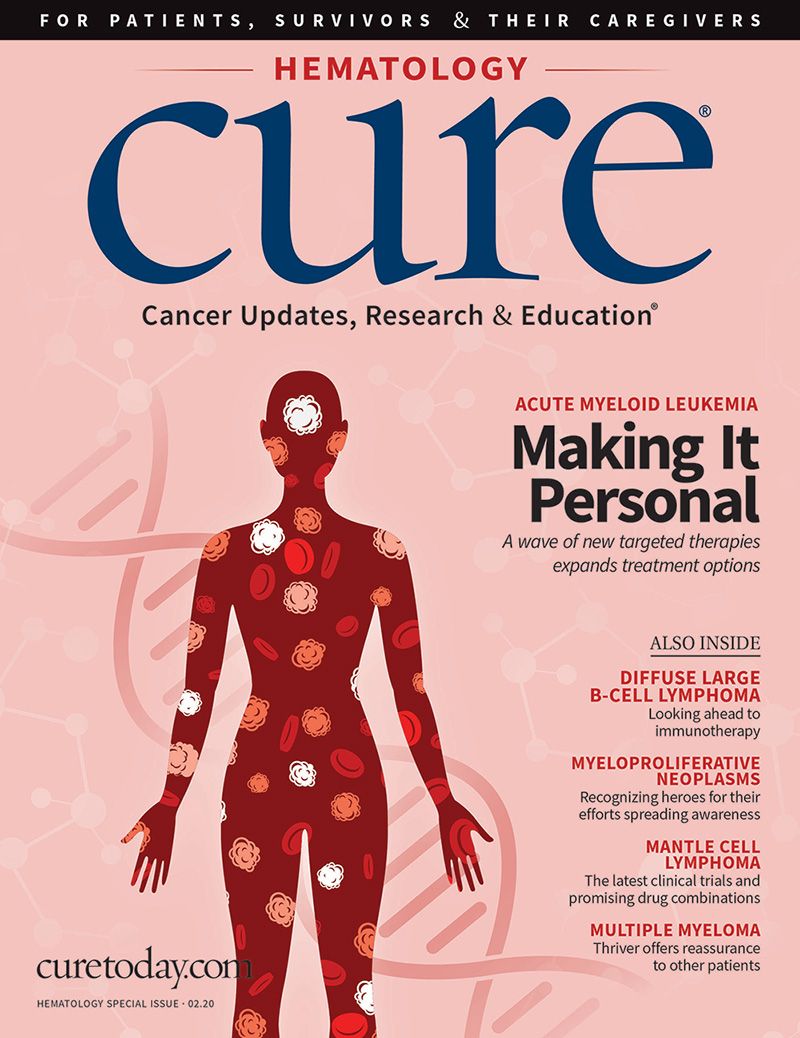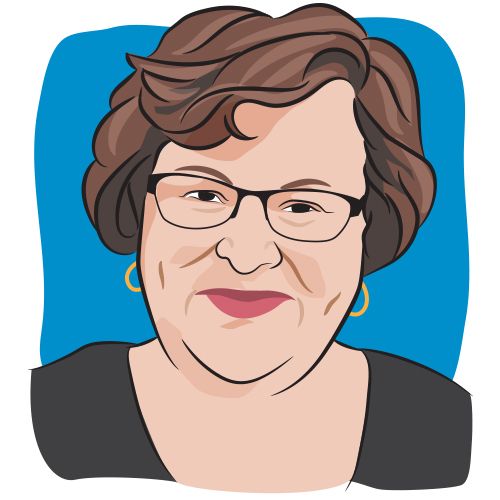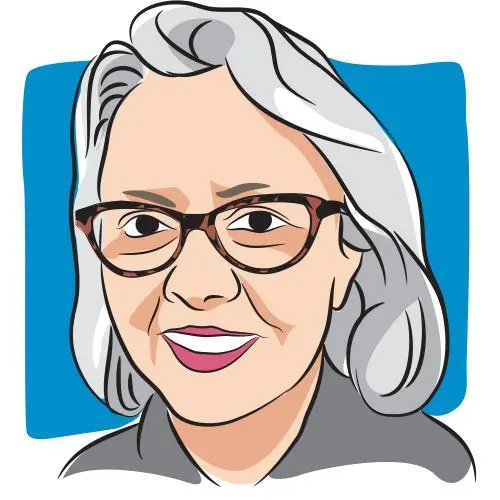Publication
Article
CURE
Eyes On New Treatments Beyond Chemotherapy in Diffuse Large B-cell Lymphoma
Author(s):
Patients with relapsed and resistant diffuse large B-cell lymphoma can look to new treatments beyond tried-and-true chemotherapy.
Almost three years to the day since doctors told Cheryl Williams she was in remission from diffuse large B-cell lymphoma (DLBCL), a routine mammogram in 2014 revealed the cancer’s return.
“They called me back to redo the mammogram, then they wanted an ultrasound, and then later a breast biopsy. In a few days, my primary care doctor called to confirm that it was the same type of lymphoma again,” recalls Williams, a 60-year-old retired early childhood educator in Chicago.
After her initial stage 4 diagnosis in 2011, Williams received standard chemotherapy,
a protocol referred to as R-CHOP — Rituxan (rituximab), Cytoxan (cyclophosphamide), Adriamycin (doxorubicin), Oncovin (vincristine sulfate) and prednisone — and went into remission. During her relapse, she received another round of chemotherapy followed by a stem cell transplant. November 2019 marked five years of remission.
During those five years, Williams underwent numerous scans, blood tests and other follow-ups to confirm her cancer-free status. “I used to worry about every single scan and blood test, but I don’t do that as much anymore,” she says. And, if Williams were to relapse, she would have more options than she did following her first diagnosis.
A large percentage of patients with DLBCL respond to initial treatment, and 71% survive more than five years. For those who don’t respond or later relapse, the condition has been harder to treat. But, in recent years, new therapies have brought hope and promising outlooks.
“This is extremely encouraging,” says Dr. Stephen Ansell, a researcher and consultant in the division of hematology at Mayo Clinic in Rochester, Minnesota. “There are now multiple therapies becoming available for patients who have had the misfortune of having the disease return.”
AGGRESSIVE DISEASE, EFFECTIVE TREATMENT
DLBCL, the most common type of non-Hodgkin lymphoma, affects more than 18,000 people each year in the United States — most often, those over age 60. The aggressive disease involves B lymphocytes, immune cells that produce antibodies to fight germs and infections entering the body. When these cells become cancerous, it wages war on the body’s built-in defense system
against infection.
But, as with the growing consensus about most cancers, DLCBL is not one disease, according to Dr. Nina Wagner- Johnston, director of lymphoma drug development at Johns Hopkins’ Sidney Kimmel Comprehensive Cancer Center in Baltimore. “It’s multiple diseases, and the better we understand their biology, the better we can target the cancer,” she says.
DLBCL breaks down into five subtypes based on behavior, appearance and defining protein or gene: T-cell/histiocyte-rich B-cell lymphoma, primary DLBCL, primary cutaneous DLBCL, Epstein- Barr virus-positive DLBCL and DLBCL not otherwise specified.
In earlier stages, when the cancer is limited to one or two lymph nodes on the same side of the diaphragm, patients typically receive three to six cycles of R-CHOP at 21-day intervals. At stage 3 or 4, patients receive six or more cycles. People at high risk of recurrence may receive different chemotherapies.
The international prognostic index score helps doctors predict risk of recurrence. This measurement takes into consideration the patient’s age and normal daily activity function, disease stage, whether the lymphoma has reached organs outside the lymphatic system and blood level of lactate dehydrogenase, a lymphoma marker. The higher the score, the higher the risk.
Williams received eight cycles of R-CHOP and felt hardest hit by the side effects of the regimen’s prednisone, a steroid. “I would have mood swings,” she recalls. “One minute I’d be happy or my normal self, and then just one word would set me off. I’d cry or have bouts of anger, and sometimes I’d be awake for 36 hours.” Other common side effects associated with R-CHOP include nausea, hair loss, fatigue, weight loss, risk of infection and loss of appetite.
The regimen might be tough to take but it is highly effective. “With R-CHOP, we are able to cure 60%-80% of patients, depending on which study you look at,” says Dr. Loretta Nastoupil, director of the department of lymphoma and myeloma at The University of Texas MD Anderson Cancer Center in Houston.
SLOW + STEADY = HOSPITAL STAY
Yet studies that examine R-CHOP don’t include enough people with a type of DLBCL known as double-hit lymphoma, who typically don’t respond well to the regimen.
B-cell lymphoma cells tend to have one or more of three possible gene mutations — BCL2, BCL6 and MYC — that occur when parts of genes swap places within the chromo- somes that contain them. Double-hit lymphoma involves two of these rearrangements, one in the MYC gene and the other in either the BCL2 or BCL6 gene.
Rather than using R-CHOP, oncologists will consider a more intensive treatment regimen of dose-adjusted EPOCH-R — etoposide phosphate, prednisone, Oncovin, Cytoxan and Adriamycin plus Rituxan, according to Nastoupil. Doctors might also consider EPOCH-R for people who have a higher international prognostic index score. Unlike other chemotherapy regimens, EPOCH is given slowly over five consecutive days.
This slow approach can reduce the toxic side effects on healthy organs,
such as the heart. The dose gradually increases until the maximum amount the patient’s bone marrow can tolerate is reached. Many patients need to stay in the hospital during the infusion.
“It was a shock to me when they told me I would need to go into the hospital for dose-adjusted EPOCH,” says Mary Chamberlain, 65, a social worker from Herndon, Virginia, who is currently receiving the regimen.
“I thought I would spend one day a week every three weeks getting chemotherapy, not five to seven days living in the hospital.”
Chamberlain gets through the stay with visits from her husband, daughter and friends. “My husband brings me breakfast every day on his way to work, and my friends bring puzzles and games,” she says. She also reads or walks the oncology ward. “Sixteen laps is a mile, so I get up and walk that, and drag the chemo machine with me,” she says. “You have to take it with you everywhere. It’s like having a dance partner.”
EPOCH-R, like R-CHOP, brings high survival rates. A 2018 study found that about 71% of people with double-hit lymphoma who received EPOCH-R remained cancer-free for four years.
A NEW PLAN OF ATTACK
If a patient doesn’t respond to therapy or, like Williams, has a relapse, the next step is typically high-dose chemotherapy followed by stem cell transplant. Now there is a new option: chimeric antigen receptor (CAR)-T cell therapy. “In the last two years, the biggest thing that’s happened in diffuse large B-cell lymphoma has been the development and approval of CAR-T cell therapy,” Nastoupil says.
The therapy involves removing a patient’s T cells, re-engineering them in a lab, and then putting them back into the patient’s body to help fight the lymphoma. The treatment forces T cells to recognize a molecule called CD19 on the surface of cancerous cells and attack.
The Food and Drug Administration has approved two CAR-T cell therapies, Kymriah (tisagenlecleucel) and Yescarta (axicabtagene ciloleucel), for people who continue to progress after at least two types of treatment. “Prior to CAR-T cell therapy, these patients were looking at a median overall survival of six months,” Nastoupil says. “Now survival is dramatically better. For the 40% of patients who are cured, we think they will have a normal life expectancy.”
Since these treatments were approved, researchers have collected data on patients who have received the therapy. That’s important, because often drugs that impress researchers in clinical trials disappoint when used in more widespread groups of patients. Clinical trial participants are often “the healthiest of sick patients,” Nastoupil says, and might do better than others would on an experimental drug. But CAR-T cell therapy continues to perform as well as it did in
clinical trials.
It works so well, in fact, that researchers want to know if CAR-T cell therapy might be more effective than high-dose chemo- therapy followed by stem cell transplant. Current clinical trials are making that comparison. If CAR-T cell therapy beats stem cell therapy, it could be used as
a second-line treatment. If the two competitors perform equally, stem cell therapy might keep its second-line spot because it costs less. Both treatments have associated risks and side effects.
Before a stem cell transplant, doctors wipe out the patient’s immune system with high-dose chemotherapy, which brings the risk of infections and other illness.
Low blood counts, another result of a depleted immune system, can thin the blood or cause anemia. Patients may experience low platelet levels, nausea, vomiting, fatigue and mouth sores. Long-term side effects, such as early menopause, thyroid problems and lung or bone damage, are also a concern.
Two major, sometimes life-threatening side effects of CAR-T cell therapy include consequences of an exuberant immune reaction, such as cytokine release syndrome and neurological toxicity. Cytokine release syndrome can cause flu-like symptoms, such as headache, fever, chills, severe nausea, vomiting, diarrhea and severe muscle or joint pain, as well as shortness of breath, low blood pressure and fast heart rate. Neurological side effects include confusion, difficulty speaking, altered consciousness and seizures. Most of these side effects can be managed with medication or resolve on their own.
INNOVATIVE IMMUNOTHERAPY
“Until treatment options work for 100% of patients, it’s not enough,” Ansell says.
Experimental drugs called bispecific T-cell engagers, or BiTEs, may help close that gap. Like CAR-T cell therapy, these drugs trigger the body’s T cells to fight lymphoma. But, for CAR-T cell therapy, doctors draw blood to modify T cells outside the body and then reinfuse them into the patient. BiTEs do not require removal and modification of T cells — they do all their work inside the body.
“The advantage is that it’s off the shelf,” Wagner-Johnston says. “It doesn’t require any of this laboratory manipulation of CAR-T cells, so you don’t have that delay.”
The bispecific drugs activate T cells by latching on to CD3, a protein on the surface of T cells, which then attach to the CD19 and CD20 proteins on cancer cells.
A recent phase 2 clinical trial included 47 patients with new diagnoses who either did not respond to R-CHOP or relapsed soon after treatment, a patient group that typically has low survival rates. Eighty-nine percent of those who received blinatumomab, a type of BiTE, responded partially or completely to the medication.
Mosunetuzumab is being examined in a phase 1 clinical trial involving 218 patients who relapsed or became resistant after multiple prior treatments, including some who had received CAR-T cell therapy. The findings showed that many patients went into complete remission after receiving the experimental drug. “One of the most encouraging things about this drug is that it even worked in some of the people who had not responded to CAR-T cell therapy,” Wagner- Johnston says.
With new treatments on the horizon and the potential for more second-line options, doctors and patients may be able to make more personalized choices. “We are already making significant strides with these novel treatments,” Wagner-Johnston says. “Now we need to try to understand which groups to target so we can maximize therapy and minimize toxicity. I think there’s lots of reason to be hopeful.”





